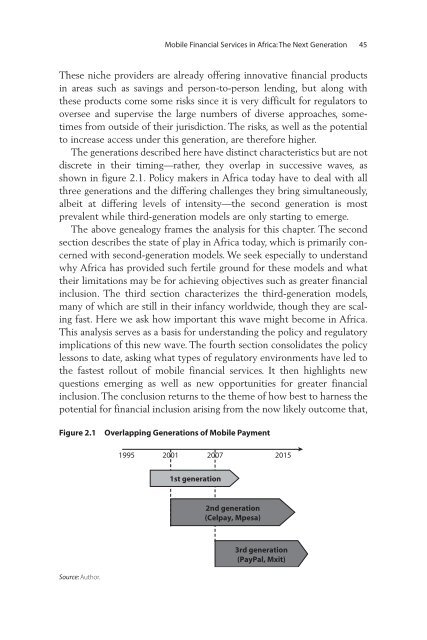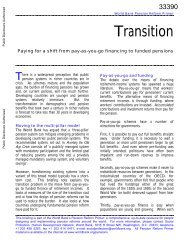Financial Sector Development in Africa: Opportunities ... - World Bank
Financial Sector Development in Africa: Opportunities ... - World Bank
Financial Sector Development in Africa: Opportunities ... - World Bank
You also want an ePaper? Increase the reach of your titles
YUMPU automatically turns print PDFs into web optimized ePapers that Google loves.
Mobile <strong>F<strong>in</strong>ancial</strong> Services <strong>in</strong> <strong>Africa</strong>: The Next Generation 45<br />
These niche providers are already offer<strong>in</strong>g <strong>in</strong>novative f<strong>in</strong>ancial products<br />
<strong>in</strong> areas such as sav<strong>in</strong>gs and person-to-person lend<strong>in</strong>g, but along with<br />
these products come some risks s<strong>in</strong>ce it is very difficult for regulators to<br />
oversee and supervise the large numbers of diverse approaches, sometimes<br />
from outside of their jurisdiction. The risks, as well as the potential<br />
to <strong>in</strong>crease access under this generation, are therefore higher.<br />
The generations described here have dist<strong>in</strong>ct characteristics but are not<br />
discrete <strong>in</strong> their tim<strong>in</strong>g—rather, they overlap <strong>in</strong> successive waves, as<br />
shown <strong>in</strong> figure 2.1. Policy makers <strong>in</strong> <strong>Africa</strong> today have to deal with all<br />
three generations and the differ<strong>in</strong>g challenges they br<strong>in</strong>g simultaneously,<br />
albeit at differ<strong>in</strong>g levels of <strong>in</strong>tensity—the second generation is most<br />
prevalent while third-generation models are only start<strong>in</strong>g to emerge.<br />
The above genealogy frames the analysis for this chapter. The second<br />
section describes the state of play <strong>in</strong> <strong>Africa</strong> today, which is primarily concerned<br />
with second-generation models. We seek especially to understand<br />
why <strong>Africa</strong> has provided such fertile ground for these models and what<br />
their limitations may be for achiev<strong>in</strong>g objectives such as greater f<strong>in</strong>ancial<br />
<strong>in</strong>clusion. The third section characterizes the third-generation models,<br />
many of which are still <strong>in</strong> their <strong>in</strong>fancy worldwide, though they are scal<strong>in</strong>g<br />
fast. Here we ask how important this wave might become <strong>in</strong> <strong>Africa</strong>.<br />
This analysis serves as a basis for understand<strong>in</strong>g the policy and regulatory<br />
implications of this new wave. The fourth section consolidates the policy<br />
lessons to date, ask<strong>in</strong>g what types of regulatory environments have led to<br />
the fastest rollout of mobile f<strong>in</strong>ancial services. It then highlights new<br />
questions emerg<strong>in</strong>g as well as new opportunities for greater f<strong>in</strong>ancial<br />
<strong>in</strong>clusion. The conclusion returns to the theme of how best to harness the<br />
potential for f<strong>in</strong>ancial <strong>in</strong>clusion aris<strong>in</strong>g from the now likely outcome that,<br />
Figure 2.1<br />
Overlapp<strong>in</strong>g Generations of Mobile Payment<br />
1995 2001 2007<br />
2015<br />
1st generation<br />
2nd generation<br />
(Celpay, Mpesa)<br />
3rd generation<br />
(PayPal, Mxit)<br />
Source: Author.







